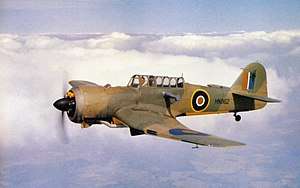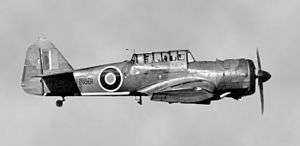Miles Martinet
The Miles M.25 Martinet was a target tug aircraft of the Royal Air Force and Fleet Air Arm that was in service during the Second World War. It was the first British aircraft to be designed specifically for target towing.
| M.25 Martinet | |
|---|---|
 | |
| Role | Target tug |
| Manufacturer | Miles Aircraft |
| First flight | 24 April 1942 |
| Primary users | Royal Air Force Royal Navy |
| Produced | 1942–1945 |
| Number built | 1,724 |
Design and development
Based upon the Miles Master II, the Martinet featured a strengthened airframe to handle the stresses of towing a target drogue. Other differences from the Master included a longer nose, higher cockpit and greater wingspan, but otherwise the two aircraft shared many common components. The targets and towing gear were contained in a fairing beneath the fuselage and were retracted by an external, wind-powered winch.[1]
The first prototype Martinet was first flown on 24 April 1942, by chief test pilot Flight Lieutenant Thomas Rose from Woodley Aerodrome. In total, 1,724 Martinets were produced by Miles Aircraft Ltd for the RAF and FAA to meet Air Ministry Specification 12/41.[1]
There were two other variants of the Martinet; the M.50 Queen Martinet, a radio-controlled target drone of which 69 were built and a further 17 produced through conversion of production Martinets. The M.37 Martinet Trainer was developed during the war but only two were built. All Martinets and their variants were manufactured at Woodley.[1]
Variants
Data from:Miles Aircraft since 1925[1]
- M.25 Martinet
- Two-seat target tug aircraft ; 1815 built.
- Martinet TT.Mk I
- Service designation for the target tug M.25
- M.50 Queen Martinet
- Unmanned radio-controlled target drone; 11 built and 58 converted from TT.1s.
- M.37 Martinet Trainer
- Two-seat training aircraft; 2 converted from TT.1s.
Operators

- Belgian Air Force (11 operated from 1947–1953 as target tugs)
- French Air Force – 41 Martinet TT.1s were delivered between 1945 and 1948.
- Irish Air Corps – two Martinet TT.1s were delivered in 1946.
- Svensk Flygtjänst AB (9 bought, 8 used as target tugs 1946–1951)
- No. 5 Squadron RAF
- No. 20 Squadron RAF
- No. 34 Squadron RAF
- No. 269 Squadron RAF
- No. 285 Squadron RAF
- No. 286 Squadron RAF
- No. 287 Squadron RAF
- No. 289 Squadron RAF
- No. 290 Squadron RAF
- No. 291 Squadron RAF
- No. 520 Squadron RAF
- No. 567 Squadron RAF
- No. 577 Squadron RAF
- No. 587 Squadron RAF
- No. 595 Squadron RAF
- No. 598 Squadron RAF
- No. 631 Squadron RAF
- No. 639 Squadron RAF
- No. 650 Squadron RAF
- No. 679 Squadron RAF
- No. 691 Squadron RAF
- No. 695 Squadron RAF
Data from:[2]
- 718 Naval Air Squadron
- 722 Naval Air Squadron
- 723 Naval Air Squadron
- 725 Naval Air Squadron
- 726 Naval Air Squadron
- 728 Naval Air Squadron
- 733 Naval Air Squadron
- 736 Naval Air Squadron
- 740 Naval Air Squadron
- 766 Naval Air Squadron
- 770 Naval Air Squadron
- 771 Naval Air Squadron
- 772 Naval Air Squadron
- 773 Naval Air Squadron
- 775 Naval Air Squadron
- 776 Naval Air Squadron
- 779 Naval Air Squadron
- 789 Naval Air Squadron
- 792 Naval Air Squadron
- 793 Naval Air Squadron
- 794 Naval Air Squadron
- 797 Naval Air Squadron
Specifications (M.25)

Data from Miles Aircraft since 1925,[1] The Hamlyn Concise Guide to British Aircraft of World War II.[3]
General characteristics
- Crew: 2
- Length: 30 ft 11 in (9.42 m)
- Wingspan: 39 ft 0 in (11.89 m)
- Height: 11 ft 7 in (3.53 m)
- Wing area: 242 sq ft (22.5 m2)
- Aspect ratio: 6.3
- Airfoil: root: NACA 23024; tip: NACA 23009
- Empty weight: 4,640 lb (2,105 kg)
- Gross weight: 6,750 lb (3,062 kg)
- Powerplant: 1 × Bristol Mercury XX or Mercury 30 9-cylinder air-cooled radial piston engine, 870 hp (650 kW)
- Propellers: 3-bladed constant-speed propeller
Performance
- Maximum speed: 221 mph (356 km/h, 192 kn) at sea level
- 240 mph (209 kn; 386 km/h) at 5,800 ft (1,768 m)
- 238 mph (207 kn; 383 km/h) at 10,000 ft (3,048 m)
- Cruise speed: 199 mph (320 km/h, 173 kn) maximum at 5,000 ft (1,524 m)
- Stall speed: 62 mph (100 km/h, 54 kn) flaps down
- 83 mph (72 kn; 134 km/h) flaps up
- Never exceed speed: 330 mph (530 km/h, 290 kn) IAS
- Range: 694 mi (1,117 km, 603 nmi)
- Endurance: 5 hours
- Time to altitude: 5,000 ft (1,524 m) in 3 minutes 30 seconds
- 10,000 ft (3,048 m) in 8 minutes
- Wing loading: 27.9 lb/sq ft (136 kg/m2)
- Take-off run: 780 ft (238 m)
- Take-off distance to 50 ft (15 m): 1,380 ft (421 m)
- Landing run: 1,275 ft (389 m)
- Landing distance from 50 ft (15 m): 1,614 ft (492 m)
Surviving aircraft
A single Martinet survives; it is owned by the Museum of Berkshire Aviation in the United Kingdom. The aircraft (RAF serial number MS902) was built in 1943, and spent its operational life in Iceland at RAF Reykjavik. In 1949, MS902 was sold to the Akureyri Flying Club and given the Icelandic civil registration TF-SHC. The club flew it until it crashed in 1951 near Kopasker in north-east Iceland. The wreckage remained at the crash site until 1977, when it was recovered and placed in storage by the Icelandic Aviation Historical Society.
The aircraft was returned to the United Kingdom in 1996 by the Museum of Berkshire Aviation and has since been the subject of a lengthy restoration project.[4][5]
See also
Related development
Related lists
References
- Brown, Don L. (1970). Miles Aircraft since 1925 (1st ed.). London: Putnam & Company Ltd. pp. 189-193. ISBN 0-370-00127-3.
- Sturtivant, Ray; Ballance, Theo (1994). The squadrons of the Fleet Air Arm ([Revised.] ed.). Tonbridge, Kent, UK: Air-Britain. p. 362. ISBN 0-85130-223-8.
- Mondey, David (1994). The Hamlyn concise guide to British aircraft of World War II. London: Chancellor Press. p. 171. ISBN 1-85152-668-4.
- "Miles M.25 Martinet TT.1." The Museum of Berkshire Aviation. Retrieved: 13 Aug 2019.
- "Martinet Restoration News." The Museum of Berkshire Aviation. Retrieved: 13 Aug 2019.
Further reading
- Amos, Peter. Miles Aircraft – The Wartime Years, 1939 to 1945. Tonbridge, Kent, UK: Air-Britain (Historians) Ltd, 2012. ISBN 978-0-85130-430-4.
External links
| Wikimedia Commons has media related to Miles M.25 Martinet. |